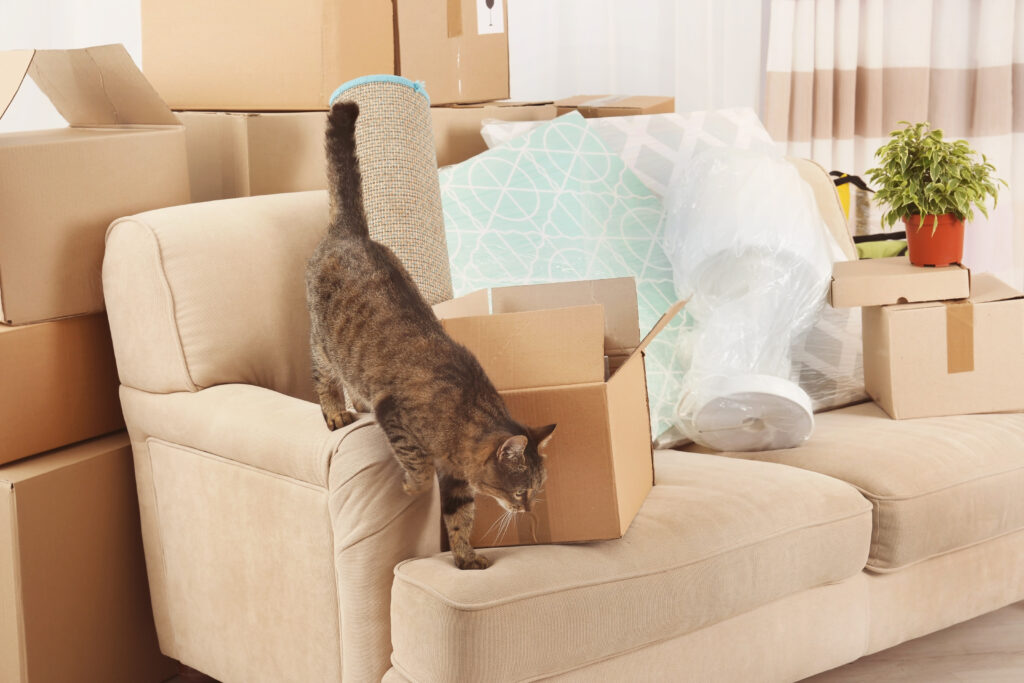How to Help Your Cat Settle in Your New Home
Relocating is complicated enough without throwing your cat into the mix. But don’t worry. With a little extra care, you can help your kitty adapt to the new home. Read this article to learn more.
Choose a Room for Your Cat
During the first few weeks after moving, your cat should stay in one room. Before unloading any moving boxes, take your cat inside that room. Your cat will probably be inside of a carrier. Set the carrier on the ground and don’t open it until you’ve cat proofed the entire room and set up your pet’s dishes, litter box, and other cat care supplies. Then you can open the carrier and allow your cat to emerge whenever he or she chooses to. Don’t force your feline to exit the carrier. Once your cat decides to come out, encourage your puss to explore by placing treats all over the room. Your cat might not be ready to leave that room for at least a few days. That’s perfectly fine. Allow your cat to stay in this secure space for as long as necessary.

Keep Your Cat Company
Although your cat is probably better off staying in one room for a while, don’t let your furry friend get lonely. Hang out with your cat each day, giving extra love and attention. You can read, listen to soothing music, watch a movie, play a game with your cat, or just cuddle.
Let Your Cat Gradually Investigate the Rest of the House
When you aren’t with your cat, you can unpack, organize, and cat-proof the rest of the home. This will make it safe for your cat to explore.When your cat seems ready to leave the room, open the door. Wait patiently for your cat to venture out. You don’t want to rush the process along too quickly. It’s a good idea to keep some of the rooms closed off so that your cat isn’t overwhelmed by all the unfamiliar sights and smells in your new home. If you provide access to only a few areas at a time, it will be much easier for your cat to get used to the house.

Provide an Additional Litter box
Just because the litter box starts out in the room where your cat initially stays, doesn’t mean that’s the best place for it. When your four-legged pal becomes more comfortable with other areas of the house, try placing a second litter box in a better spot. Show your cat where the second litter box is. After a few weeks, you can either remove the first litter box or you can place it in another, more suitable location. If you plan on relocating the first litter box, move it a little closer to its desired location each day. This will be a gradual process.
Ease Your Cat’s Stress and Anxiety
Moving can stress out your furball. Here are some helpful tips for reducing that stress.
Hide the Moving Boxes
After relocating to your new home, moving boxes will probably be scattered throughout the house while you work on unpacking. But if the sight of those boxes reminds your cat of the move, they might make your kitty nervous. So, what are you to do? The best way to handle this problem is to organize the areas your cat will be checking out first before dealing with the other rooms that will be temporarily off-limits. Remember, when your cat leaves his or her initial room, you will block off certain areas of your house. Ideally, those blocked areas will be the rooms that still contain moving boxes.


Don’t Stray from the Routine
We realize that moving can throw your life into a tizzy until you have settled into your new place. But try to avoid disrupting your cat’s regular routine as much as you can. Continue to feed, groom, and play with your kitty at the same time each day. Don’t let yourself become so engrossed in unpacking that you miss a play session or forget to feed your cat on schedule.
Talk to Your Veterinarian
If your cat already tends to suffer from anxiety, moving isn’t going to help. Anti-anxiety meds or natural remedies may be necessary for helping your feline cope with the changes. You should speak with your veterinarian about this.
Let’s face it. Moving is hard. But it doesn’t have to be traumatic for you or your feline friend. Just follow the steps in this article to make the entire process smoother and less stressful for your cat.
Want some more Savvy Secrets? Check them out:
The Safe Pet Travel Checklist for Weekend Trips
Understanding Your Male Bengal Cat: A Guide to Their Needs and Wants
Understanding Your Male Bengal Cat: A Guide to Their Needs and Wants Imagine living with…
How to Clean and Maintain Your Dog’s 8-Month Flea and Tick Collar for Optimal Protection
What Should You Do Right After A Dog Bite?
About the Author:
Savanna Westwood
Savanna Westwood is the Owner and Founder of The Savvy Sitter, Pet Sitting and Dog Walking, LLC. She has grown up with animals all her life and enjoys spending time with them. Savanna has lived in the Winter Garden and Windermere Area for over 30 years. When she is not taking care of Fur Friends, one can find her reading, practicing archery, riding, and devising ways to provide additional and excellent services to clients. Savanna is a Certified Professional Pet Sitter with Pet Sitter International's CPPS certification and also holds certification in Pet First Aid and CPCR for Pet-Care Professionals.





